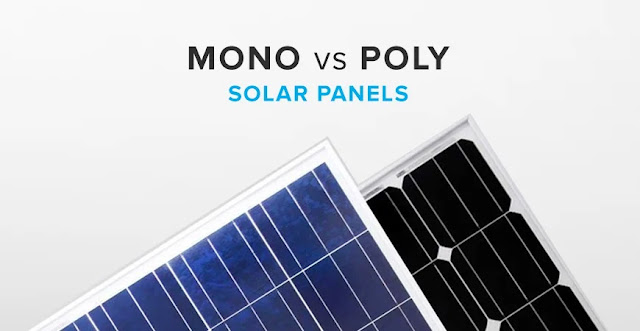Photovoltaic solar panels are divided into two main categories: mono-crystalline solar panels and poly-cystalline solar panels. This article is intended for those wishing to know the differences between these two types of solar panels.
What is the difference between monocrystalline and polycrystalline solar panels?
The main difference between the two technologies is in the crystal purity of the panel cells. Monocrystalline solar panels have solar cells made from a single crystal of silicon while polycrystalline solar panels have solar cells made from several fragments of silicon melted together. The crystalline purity of the cells of monocrystalline solar panels is therefore much higher than that of polycrystalline solar panels.
The image below shows you how to distinguish the two different types of solar panels. Monocrystalline cells are black and octagonal while polycrystalline cells are dark blue and squared.
What is the difference in performance?
The efficiency of a solar panel is the ratio between the amount of energy it collects compared to the amount of energy it produces, the rest being lost in heat. An efficiency of 20% means that 20% of the solar radiation is transformed into electricity and that the missing 80% is transformed into heat. The higher the efficiency, the greater the amount of electricity produced.
That said, monocrystalline solar panels perform better than polycrystalline solar panels due to the fact that monocrystalline solar cells are composed of a single crystal rather than a conglomerate of crystals, which increases their spectral response and thereby their energy production.
Concretely, the efficiency of monocrystalline solar panels varies between 19 and 24% while that of polycrystalline solar panels varies between 18 and 20%. That means that on an equal surface, monocrystalline solar panels are more efficient. These panels are often suggested for those whose space is a limiting factor.
Another great advantage of monocrystalline solar panels is that the crystal purity of their cells means that their production starts earlier and stops later than a polycrystalline solar panel. Not only being more efficient, this type of panel will have a longer energy production period than that of a polycrystalline solar panel.
What is the difference in service life?
Both types of solar panels have two warrantees, a physical warranty and an efficiency warranty. The physical warranty is generally 15 to 30 years and covers any physical damage. The efficiency warranty is 20 to 30 years and concerns the efficiency of solar panels after 25 years. Thus, an 80% efficiency warranty after 25 years means that the panels will produce 80% of the electricity they produced in their first year after 25 years. Although they produce less energy, the panels still work very well.
That said, the duration of warranties varies by manufacturer rather than panel technology. It is up to you to choose the manufacturer offering the best warrantees.
What is the difference in looks?
What is the difference in price?
Monocrystalline solar panels are often more expensive than polycrystalline solar panels since their manufacturing process is more energy-consuming and complex. Indeed, the cost per watt of polycrystalline solar panels is generally between Rs 24 and Rs 28 while that of monocrystalline solar panels is between Rs 28 and Rs 30.
However, the efficiency of monocrystalline solar panels is higher than that of polycrystalline solar panels. Although they are more expensive (and more beautiful according to many), they produce more energy. Knowing that the lifespan of a solar panel is 25 to 40 years, the additional cost is very often worth it.
What is the difference in topology?
Both monocrystalline and polycrystalline panels are made from silicon, a conductive material that allows photovoltaic cells in solar panels to generate electricity from solar radiation. Silicon is not found in its natural state, but comes from silica, a chemical element found in our earth’s crust.
Once extracted, the silica is refined into silicon to then be crystallized in the form of ingots which will finally be cut into thin strips - commonly known as wafers. All of these processes have a high ecological footprint since they are polluting and energy consuming.
That said, the ecological footprint of a monocrystalline solar panel is higher than that of a polycrystalline solar panel since its manufacture causes two to three times more material loss. However, knowing that the efficiency of monocrystalline solar panels is higher than that of polycrystalline solar panels, its ecological footprint will be compensated faster than that of a polycrystalline solar panel.
Means:
In summary, monocrystalline solar panels have solar cells made from a single silicon crystal while polycrystalline solar panels have solar cells made from multiple fragments of silicon crystals melted together. This manufacturing difference means that the spectral response of monocrystalline solar panels is higher, which gives them better performance. Although they are more expensive, the fact that they can produce more energy offsets their additional cost, especially knowing that their lifespan is at least 25 years. In addition, their black color is more discreet and works better with a conventional shingle roof. Monocrystalline solar panels are definitely the best type of solar panel.
Please do not hesitate to contact us for more information, we will be happy to assist you. Our affordable, reliable and turnkey solar energy systems will fully satisfy you. Give us the chance to impress you and share our solar expertise with you.



Comments
Post a Comment
https://lobelpower.com/
HOTLINE NO 9998931555